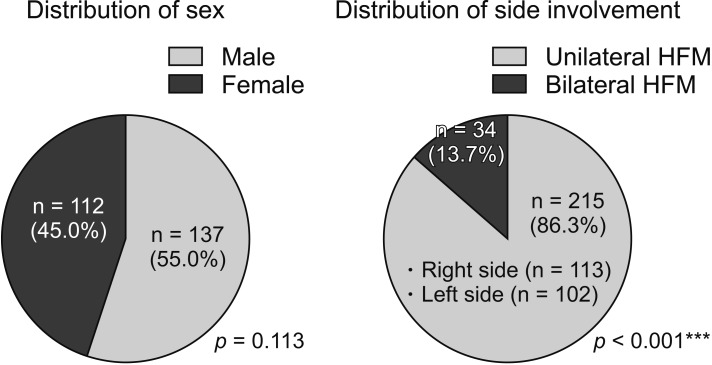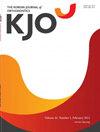面肌短型的分布和表型及其与其他异常的关系。
IF 1.9
3区 医学
Q1 Dentistry
Korean Journal of Orthodontics
Pub Date : 2020-01-01
Epub Date: 2020-01-22
DOI:10.4041/kjod.2020.50.1.33
引用次数: 6
摘要
目的:探讨面神经畸形(HFM)的分布、表型及其与其他异常的关系。方法:本研究纳入了249名韩国HFM患者,其图表、照片、x线片和/或计算机断层扫描于1998-2018年从首尔国立大学医院和牙科医院获得。统计分析按性别、侧受累、下颌畸形程度、下颌体代偿生长、角度分类的患病率及其与其他异常的关系。结果:男性和女性患者的患病率无显著性差异(55.0%比45.0%,p > 0.05)。单侧HFM (UHFM)比双侧HFM (BHFM)更为普遍(86.3% vs. 13.7%, p < 0.001)。尽管UHFM患者的Pruzansky-Kaban型分布有显著差异(I, 53.0%;活动花絮,18.6%;IIb, 24.7%;第三,3.7%;P < 0.001),左右两侧的发生率无差异(52.6%比47.4%,P > 0.05)。在BHFM患者中,左右两侧不同Pruzansky-Kaban型的患病率大于两侧相同型的患病率(67.6% vs. 32.4%, p < 0.05)。尽管髁/支复合体发育不全,35例患者(14.1%)出现同侧下颌骨体代偿性生长。I类和II类磨牙关系比III类磨牙关系更普遍(93.2% vs. 6.8%, p < 0.001)。其他异常48例(19.3%),BHFM组为50.0%,UHFM组为14.4% (p < 0.001)。结论:HFM患者需要个性化的诊断和治疗计划,因为其不同的表型和与其他异常的关联。本文章由计算机程序翻译,如有差异,请以英文原文为准。



Distribution and phenotypes of hemifacial microsomia and its association with other anomalies.
Objective To investigate the distribution and phenotypes of hemifacial microsomia (HFM) and its association with other anomalies. Methods This study included 249 Korean patients with HFM, whose charts, photographs, radiographs, and/or computed tomography scans acquired during 1998–2018 were available from Seoul National University Hospital and Dental Hospital. Prevalence according to sex, side involvement, degree of mandibular deformity, compensatory growth of the mandibular body, and Angle's classification, and its association with other anomalies were statistically analyzed. Results Prevalence was not different between male and female patients (55.0% vs. 45.0%, p > 0.05). Unilateral HFM (UHFM) was more prevalent than bilateral HFM (BHFM) (86.3% vs. 13.7%, p < 0.001). Although distribution of the Pruzansky–Kaban types differed significantly in patients with UHFM (I, 53.0%; IIa, 18.6%; IIb, 24.7%; III, 3.7%; p < 0.001), no difference was observed in occurrence between the right and left sides (52.6% vs. 47.4%, p > 0.05). Among patients with BHFM, prevalence of different Pruzansky–Kaban types on the right and left sides was greater than that of the same type on both sides (67.6% vs. 32.4%, p < 0.05). Despite hypoplasia of the condyle/ramus complex, compensatory growth of the mandibular body on the ipsilateral side occurred in 35 patients (14.1%). Class I and II molar relationships were more prevalent than Class III molar relationships (93.2% vs. 6.8%, p < 0.001). Forty-eight patients (19.3%) had other anomalies, with 50.0% and 14.4% in the BHFM and UHFM groups (p < 0.001). Conclusions Patients with HFM require individualized diagnosis and treatment planning because of diverse phenotypes and associations with other anomalies.
求助全文
通过发布文献求助,成功后即可免费获取论文全文。
去求助
来源期刊

Korean Journal of Orthodontics
Dentistry-Orthodontics
CiteScore
2.60
自引率
10.50%
发文量
48
审稿时长
3 months
期刊介绍:
The Korean Journal of Orthodontics (KJO) is an international, open access, peer reviewed journal published in January, March, May, July, September, and November each year. It was first launched in 1970 and, as the official scientific publication of Korean Association of Orthodontists, KJO aims to publish high quality clinical and scientific original research papers in all areas related to orthodontics and dentofacial orthopedics. Specifically, its interest focuses on evidence-based investigations of contemporary diagnostic procedures and treatment techniques, expanding to significant clinical reports of diverse treatment approaches.
The scope of KJO covers all areas of orthodontics and dentofacial orthopedics including successful diagnostic procedures and treatment planning, growth and development of the face and its clinical implications, appliance designs, biomechanics, TMJ disorders and adult treatment. Specifically, its latest interest focuses on skeletal anchorage devices, orthodontic appliance and biomaterials, 3 dimensional imaging techniques utilized for dentofacial diagnosis and treatment planning, and orthognathic surgery to correct skeletal disharmony in association of orthodontic treatment.
 求助内容:
求助内容: 应助结果提醒方式:
应助结果提醒方式:


